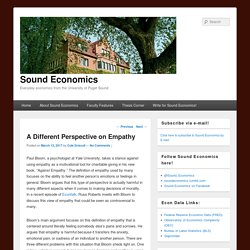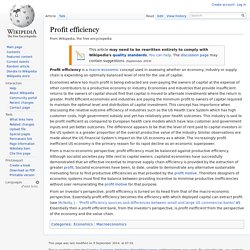

A Different Perspective on Empathy. Paul Bloom, a psychologist at Yale University, takes a stance against using empathy as a motivational tool for charitable giving in his new book, “Against Empathy.”

The definition of empathy used by many focuses on the ability to feel another person’s emotions or feelings in general. Bloom argues that this type of perspective is actually harmful in many different aspects when it comes to making decisions of morality. In a recent episode of Econtalk, Russ Roberts meets with Bloom to discuss this view of empathy that could be seen as controversial to many. Bloom’s main argument focuses on this definition of empathy that is centered around literally feeling somebody else’s pains and sorrows.
About rational economic behaviour. Six Questions on the Cost of Corruption with World Bank Institute Global Governance Director Daniel Kaufmann. Cobb-Douglas-productiefunctie. Blockchain. Lorenz curve. In economics, the Lorenz curve is a graphical representation of the distribution of income or of wealth.

Gini coefficient. The consequence of growth. The Great Decoupling. As machine learning advances at exponential rates, many highly skilled jobs once considered the exclusive domain of humans are increasingly being carried out by computers.

Whether that’s good or bad depends on whom you talk to. Technologists and economists tend to split into two camps, the technologists believing that innovation will cure all ills, the economists fretting that productivity gains will further divide the haves from the have-nots. Priority Theory of Value. The Great Escape (Angus Deaton) 21 hours. 21 hours A ‘normal’ working week of 21 hours could help to address a range of urgent, interlinked problems: overwork, unemployment, over-consumption, high carbon emissions, low well-being, entrenched inequalities, and the lack of time to live sustainably, to care for each other, and simply to enjoy life.

February 13, 2010 // Written by: Werkwijze Apple zuigt samenleving leeg. Table 5: Gender-related development index (GDI) Download all data Table 5: Gender-related development index (GDI) Notes a.

Because disaggregated income data are not available, data are crudely estimated. See Definitions and Technical note 4 at for details on the methodology.b. World Economic Forum - The Global Competitiveness Report 2015-2016. Avinash Kaushik - Photos du journal. New study finds fastest-growing cities not the most prosperous. Los Angeles, CA (July 19, 2012) As communities seek new ways to emerge from the recession, many may look to growing their population as a strategy.

However, the belief that population growth will bring jobs and economic prosperity for local residents is a myth. These findings are published in a new study in the latest issue of Economic Development Quarterly (published by SAGE). "Growth may be associated with economic development success; however, it is not the cause of that success," wrote study author Eben Fodor. Fodor examined the relationship between growth and economic prosperity in the 100 largest U.S. metropolitan areas from 2000 to 2009 to determine whether certain benefits commonly attributed to growth are supported by statistical data. He found that the slowest-growing metro areas had lower unemployment rates, lower poverty rates, higher income levels, and were less impacted by the recession than the fastest-growing areas.
Profit efficiency. Profit efficiency is a macro-economic concept used in assessing whether an economy, industry or supply chain is expending an optimally balanced level of rent for the use of capital.

Economies where too much profit is being extracted are over-paying the owners of capital at the expense of other contributors to a productive economy or industry. Economies and Industries that provide insufficient returns to the owners of capital should find that capital is moved to alternate investments where the return is greater. Profit Efficient economies and industries are paying the minimum profit to owners of capital required to maintain the optimal level and distribution of capital investment. This concept has importance when discussing the relative outcome efficiency of industries such as the US Health Care System which has high customer costs, high government subsidy and yet has relatively poor health outcomes. Tendency of the rate of profit to fall. The tendency of the rate of profit to fall (TRPF) is a hypothesis in economics and political economy, most famously expounded by Karl Marx in chapter 13 of Das Kapital, Volume 3.

Although no longer accepted in mainstream economics, the existence of such a tendency was more widely accepted in the 19th century.[1] Karl Marx on the TRPF[edit] Simply put, Marx argued that technological innovation enabled more efficient means of production. Physical productivity would increase as a result, i.e. a greater output (of use values, i.e., physical output) would be produced, per unit of capital invested. Small Government is Code for Corporate Dominance. Untitled. September 2009 If I tell someone I am a financial mathematician, they often think I am an accountant with pretensions.

Since accountants do not like using negative numbers, one of the oldest mathematical technologies, I find this irritating. A roll of the dice I was drawn into financial maths not because I was interested in finance, but because I was interested in making good decisions in the face of uncertainty. Economic Myths. U.S. National Debt Clock : Real Time. Les questions relatives aux enjeux futurs du partenariat Maroc / UE.